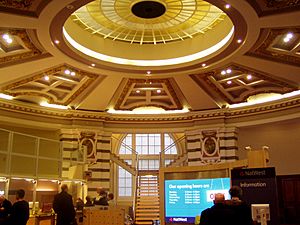NatWest facts for kids
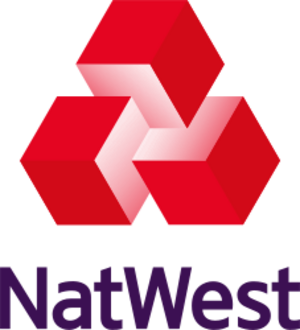 |
|
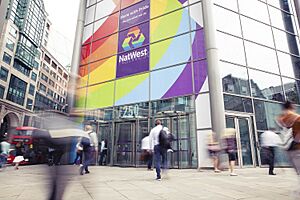
NatWest's headquarters at 250 Bishopsgate in the City of London
|
|
|
Trade name
|
NatWest |
|---|---|
|
Formerly
|
National Westminster Bank Limited (1968-1981) |
| Industry | Financial services |
| Predecessor | National Provincial Bank Westminster Bank District Bank |
| Founded | 18 March 1968 |
| Headquarters | London, England, UK |
|
Key people
|
Chairman: Sir Howard Davies Chief Executive: Paul Thwaite |
| Products | Banking, Investments, Lending and Insurance |
| Parent | NatWest Holdings |
| Subsidiaries | Coutts |
National Westminster Bank, trading as NatWest, is a major retail and commercial bank in the United Kingdom based in London, England. It was established in 1968 by the merger of National Provincial Bank and Westminster Bank. In 2000, it became part of The Royal Bank of Scotland Group, which was re-named NatWest Group in 2020. Following ringfencing of the group's core domestic business, the bank became a direct subsidiary of NatWest Holdings; NatWest Markets comprises the non-ringfenced investment banking arm. The British government currently owns 35% of NatWest Group after spending £45 billion ($61.87 billion) bailing out the lender in 2008; the proportion at one point was 54.7%. NatWest International is a trading name of RBS International, which also sits outside the ringfence.
NatWest is considered one of the Big Four clearing banks in the UK, and it has a large network of over 960 branches and 3,400 cash machines across Great Britain and offers 24-hour Actionline telephone and online banking services. Today, it has more than 7.5 million personal customers and 850,000 small business accounts. In Northern Ireland, it operates through the Ulster Bank brand.
Contents
History
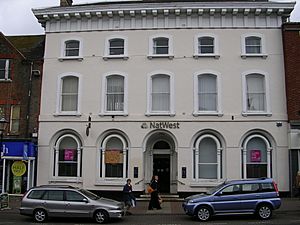
The bank's origins date back to 1658 with the foundation of Smith's Bank of Nottingham. Its oldest direct corporate ancestor, National Provincial Bank, was formed in 1833 as the National Provincial Bank of England. It merged with Union of London and Smith's Bank in 1918 to become National Provincial and Union Bank, shortening its name in 1924. District Bank (formed in 1829 as the Manchester and Liverpool District Banking Company) was acquired by National Provincial in 1962 and allowed to operate under its own name. Westminster Bank was formed in 1834 as London and Westminster Bank. It merged with London and County Bank in 1909 to become London County and Westminster Bank and with Parr's Bank in 1918 to become London County Westminster and Parrs Bank, shortening its name in 1923.
The creation of the modern bank was announced in 1968 and commenced trading on 1 January 1970 after the statutory process of integration had been completed in 1969. The three arrowheads device was adopted as the new bank's logo; it is said to symbolise either the circulation of money in the financial system or the bank's three constituents. The District, National Provincial and Westminster banks were fully integrated in the new firm's structure, but private bankers Coutts & Co (a 1920 National Provincial acquisition, established 1692), Ulster Bank in Northern Ireland (a 1917 Westminster acquisition, established 1836) and the Isle of Man Bank (a 1961 National Provincial acquisition, established 1865) continued as separate operations. Westminster Foreign Bank (established 1913) was restyled International Westminster Bank in 1973. Duncan Stirling, outgoing chairman of Westminster Bank, became first chairman of the fifth-largest bank in the world. In 1969 David Robarts, former chairman of National Provincial, assumed Stirling's position. In 1975 it was one of the first London banks to open a representative office in Scotland. It was a founder member of the Joint Credit Card Company (with Lloyds Bank, Midland Bank and Williams & Glyn's Bank) which launched the Access credit card (now part of Mastercard) in 1972 and in 1976 it introduced the Servicetill cash machine. The same banks, excluding Lloyds, were later responsible for the introduction of the Switch debit card (later branded Maestro) in 1988.
Expansion
Deregulation in the 1980s, culminating in the Big Bang in 1986, also encouraged the bank to enter the securities business. County Bank, its merchant banking subsidiary formed in 1965, acquired various stockbroking and jobbing firms to create the investment banking arm County NatWest. National Westminster Home Loans was established in 1980 and other initiatives included the launch of the Piggy Account for children in 1983, the Credit Zone, a flexible overdraft facility on which customers only pay interest (now commonplace, this so-called pink debt was innovative when launched) and the development of the Mondex electronic purse (later sold to MasterCard Worldwide) in 1990. The Action Bank advertising campaign spearheaded a new marketing-led approach to business development. Under the direction of Robin Leigh-Pemberton, who became chairman in 1977, the bank also expanded internationally, forming National Westminster Bancorp in the United States of America with a network of 340 branches across two states, National Westminster Bank of Canada and NatWest Australia Bank; and opening branches on the European continent and in the Far East. In 1982, the Frankfurt office of International Westminster Bank merged with Global Bank AG to form Deutsche Westminster Bank. In 1985, Banco NatWest España was formed and National Westminster Bank SA was incorporated in 1988, taking over the bank's six branches in France and Monaco. In 1989, International Westminster Bank was merged into National Westminster Bank by Act of Parliament.
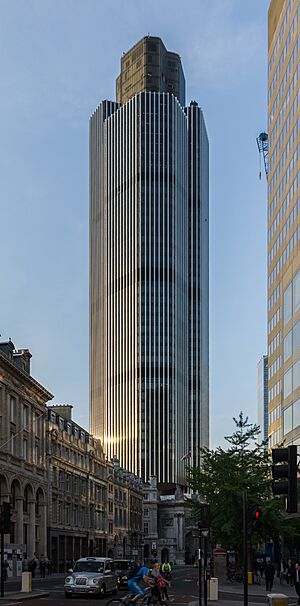
Completed in 1980, the bank built the National Westminster Tower (now known as Tower 42) in London to serve as its international headquarters. At a height of 600 feet (183 m) it was the tallest building in the UK until the topping-out of Canary Wharf Tower 10 years later; its footprint loosely approximating the bank's logo when viewed from the air, although the architect claimed the similarity was coincidence. Also worthy of note is National Westminster House (since renamed as 103 Colmore Row) in Birmingham: the building was sold to British Land in 2007 and demolished in 2015.
Takeover
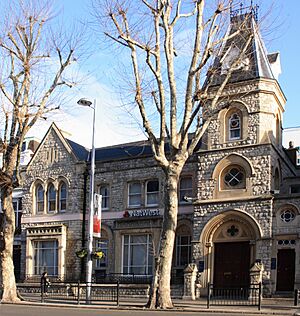
In 1999, the chairman, Lord Alexander of Weedon, announced a merger with Legal & General in a friendly £10.7 billion deal, the first between a bank and an insurance company in UK history. The move was poorly received in the London financial markets and NatWest's share price fell substantially. Seen as a driver of the ill-advised investment banking expansion, Derek Wanless was forced to resign as chief executive following the appointment of Sir David Rowland (who became executive chairman). Also in 1999, in response to the much reduced NatWest market capitalisation, the much smaller Bank of Scotland made a hostile takeover bid for NatWest. The Bank of Scotland's aim was to break up the NatWest Group and dispose of its non-retail assets. NatWest was forced to abandon its merger, but refused to agree to a takeover by a rival bank. The Royal Bank of Scotland tabled another hostile offer, of £21 billion, outbidding the Bank of Scotland. The takeover of NatWest in early 2000 was the biggest in UK history. Once Britain's most profitable bank, it was delisted from the London Stock Exchange and became, with its subsidiaries, component parts of the Royal Bank of Scotland Group. The outcome of this bitter struggle set the tone for a round of consolidation in the financial sector as it prepared for a new age of fierce global competition. The Royal Bank of Scotland Group became the second-largest bank in the UK and Europe (after HSBC) and the fifth-largest in the world by market capitalisation. According to Forbes Global 2000, it was then the 13th-largest company in the world. NatWest was retained as a distinct brand with its own banking licence, but many back office functions were merged with those of the Royal Bank, leading to over 18,000 job losses.
Attempted divestment
In 2008, it was announced that HM Government would take a stake of up to 58% in the Royal Bank of Scotland in a move aimed at recapitalising the group. HM Treasury subscribed for £5 billion in preference shares and underwrote the issuance of £15bn of new ordinary shares offered to RBS shareholders and new institutional shareholders at the fixed price of 65.5p. As a consequence of the mismanagement that necessitated this rescue, the chief executive, Fred Goodwin (who secured the takeover of NatWest), offered his resignation, which was duly accepted. Chairman Tom McKillop also confirmed he would stand down from that role when his contract expired in 2009. Goodwin was replaced by Stephen Hester, previously chief executive of British Land.
In 2009, the RBS Group announced that it would divest all 311 RBS branches in England and Wales (known as Williams & Glyn's until 1985) together with the seven NatWest branches in Scotland as a standalone business, to comply with European Commission state aid requirements. In August 2010, it was announced that the branches would be sold to Santander UK, along with the accounts of 1.8 million personal customers and 244,000 SME customers. Santander withdrew from the sale in October 2012. On 27 September 2013, the RBS Group confirmed it had agreed to sell 308 RBS branches in England and Wales and 6 NatWest branches in Scotland to the Corsair consortium. This figure was reduced to 307 by May 2015. The branches were to have been separated from the group in 2016 as a standalone business operating under the previously dormant Williams & Glyn brand.
In August 2016, RBS cancelled its plan to spin off Williams & Glyn as a separate business, stating that the new bank could not survive independently. It revealed it would instead seek to sell the division to another bank. In February 2017, HM Treasury and the European Commission reached a provisional agreement in which RBS would be able to retain the Williams & Glyn assets in return for investing £750 million into a fund aimed at increasing SME lending by challenger banks and for RBS agreeing to allow SME customers of challenger banks to use its branch network for cash and cheque handling. The European Commission confirmed in April 2017 that it would scrutinise the proposal.
Recent developments
On 3 May 2021, the business of Ulster Bank Limited in Northern Ireland was transferred to National Westminster Bank as part of a court-approved Banking Business Transfer Scheme.
Structure
NatWest Group operates internationally through its four principal subsidiaries: NatWest Holdings which owns The Royal Bank of Scotland, National Westminster Bank and Ulster Bank Ireland DAC; NatWest Markets; NatWest Markets N.V.; and The Royal Bank of Scotland International. The NatWest sub-group of companies comprises National Westminster Bank and its subsidiary and associated undertakings. As of 2023[update], the principal subsidiary undertakings of NatWest are:
- Coutts & Co.
- RBS Invoice Finance
- Lombard North Central
Structurally, National Westminster Bank was a wholly owned subsidiary of The Royal Bank of Scotland Group until 2003, when ownership of the bank's entire issued ordinary share capital was transferred to The Royal Bank of Scotland as holding company, with RBS Group functioning as ultimate holding company. At the same time the entire issued share capital of Lombard North Central was transferred by the bank to the holding company, transferring back to NatWest in 2017. Ownership of National Westminster Home Loans was passed to the holding company in 2005; however, the mortgage portfolio and related funding were also transferred back to NatWest in 2012. In 2000, the bank transferred National Westminster Life Assurance to RBS Life Investments, effectively establishing the business as a joint venture between the Group and Norwich Union. In 2018, ownership of both NatWest and the Royal Bank transferred to NatWest Holdings and NatWest became the main provider of shared services and Treasury activities for the RBS Group. On 14 February 2020, it was announced that RBS Group would be renamed NatWest Group later that year, taking the brand under which the majority of its business was delivered. The change became effective on 22 July.
The following have served as chairmen of National Westminster Bank:
| Tenure | Incumbent |
|---|---|
| 1968–1969 | Duncan Stirling |
| 1969–1971 | David Robarts |
| 1971–1977 | Sir John Prideaux |
| 1977–1983 | Robin Leigh-Pemberton, later the Lord Kingsdown |
| 1983–1989 | The Lord Boardman |
| 1989–1999 | The Lord Alexander of Weedon |
| 1999–2000 | Sir David Rowland |
The office is currently held ex officio by the chair of NatWest Group.
Services

NatWest provide a full range of banking and insurance services to personal, business and commercial customers, including the first dedicated bank account in Britain to be delivered and supported entirely in the Polish language. The bank has won Your Mortgage Magazine's Best Bank for Mortgages award 13 times in the last 17 years, more than any other lender.
Operating under the name Esme Loans, NatWest provides a digital lending platform for SMEs also available to customers not banking with NatWest or RBS. Esme Loans commenced trading on 17 February 2017, after being founded out of the bank's new product development programme NatWest Innovation Cell by Richard Kerton, Veronika Lovett, and Lucy Hasson.
The bank operates "mobile branches" using converted vans to serve rural areas around St Austell, Swansea, Carlisle, Devon and North Wales. The service allows to customers to carry out banking transactions in remote areas where there is no branch. NatWest reintroduced the mobile service in Cornwall in 2005, after HSBC ended its own version due to costs.
In 2006, the then RBS Group undertook the first trial of PayPass contactless debit and credit cards in Europe. In 2019, a NatWest pilot project was the first in the UK to trial debit cards containing fingerprint authentication technology developed by Dutch company, Gemalto.
The bank participates fully in the Faster Payments Service, an initiative to speed up certain payments, launched in 2008. The bank established credit and debit card payment handling company Streamline in 1989, which was merged into Worldpay Group in 2009. The NatWest Mobile Banking app is available to personal account holders over the age of 11 with online banking, a debit card and UK mobile telephone number (beginning 07). The Emergency Cash service gives access to cash without a debit card from NatWest, RBS and Ulster Bank cash machines.
NatWest is a member of the Cheque and Credit Clearing Company, Bankers' Automated Clearing Services, the Clearing House Automated Payment System and the LINK Interchange Network. The bank is authorised by the Prudential Regulation Authority and regulated by both the Financial Conduct Authority and the Prudential Regulation Authority. It is a member of the Financial Ombudsman Service, the Financial Services Compensation Scheme, UK Payments Administration and of the British Bankers' Association; and it subscribes to the Lending Code. Mortgages, available in England, Scotland and Wales only, are provided by National Westminster Home Loans, a member of the Council of Mortgage Lenders,
The NatWest One account is a secured personal account with the Royal Bank of Scotland.
NatWest Insurance Services acts as intermediary and broker for general insurance, policies are underwritten by UK Insurance Limited. Life Protector and Guaranteed Bond products are provided by National Westminster Life Assurance.
The Royal Bank of Scotland International trades as NatWest International in Jersey, Guernsey, the Isle of Man and Gibraltar. In 2010, RBS Intermediary Partners was renamed NatWest Intermediary Solutions.
National Westminster Bank use the following series of six digit sorting codes formatted into three pairs separated by hyphens:
| Range | Note |
|---|---|
| 01 | Former District Bank |
| 50-00 to 59-99 | Former National Provincial Bank |
| 55-91 | In use by Isle of Man Bank |
| 60-00 to 66-99 | Former Westminster Bank |
| 18 | For use of Coutts & Co. |
| 98 | For use of Ulster Bank |
International Bank Account Numbers take the form GBxx NWBK ssss ssaa aaaa aa, where x refers to two check digits, s to the branch sort code and a to the individual account number. The Bank Identifier Code, or SWIFT code, for NatWest (and Isle of Man Bank) is NWBKGB2L (8 digits) or NWBKGB2Lxxx (11 digits).
Bó, a standalone digital banking app with the aim of helping people save more money was launched in November 2019 and discontinued in May 2020.
Mettle is an e-money business account provided by Prepay Solutions, a trading name of Prepay Technologies Ltd.
NatWest also entered the merchant acquiring market by introducing Tyl in 2019. The proposition includes next business day settlement for card transactions.
Sponsorship
The name NatWest has been associated with cricket tournaments held in England. From 1981 until 2000, the bank was the title sponsor of English domestic cricket's main limited overs knockout tournament, which was known as the NatWest Trophy during that period. Between 2000 and 2013, the NatWest Series was an annual one-day international tournament involving England and two visiting international teams. NatWest was also a main sponsor of the 1999 Cricket World Cup, held in England. Since May 2017, it has been the shirt sponsor for the England men's and women's cricket teams. The bank also sponsored England's Test series against Pakistan in 2018.
NatWest is sponsor of the Southern Paintball League, the leading competitive paintball series in the south of England.
NatWest was the main sponsor of the Island Games (known at the time as the NatWest Island Games) from 1999 through to 2019.
NatWest CommunityForce is "a platform that empowers local projects and charities to raise awareness of their work and make their plans a reality with the support of NatWest and their local community."
See also
- Nestle v National Westminster Bank plc
- Re Spectrum Plus Ltd
- Tournier v National Provincial and Union Bank of England
- Office of Fair Trading v Abbey National plc


